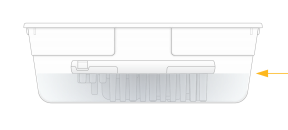Thaw Consumables
Use the following instructions to thaw consumables before sequencing.
Use the following instructions to thaw the reagent cartridge in a room temperature water bath (15°C to 30°C).
Inserting the library tube strip or lyo insert into the reagent cartridge while thawing might cause reduced data quality or run failure.
| 1. | Put on a new pair of powder-free gloves and remove the cartridge from -25°C to -15°C storage. |
| 2. | Remove the cartridge from the box, and then remove it from the bag. |
| 3. | Submerge the reagent cartridge in a room temperature, laboratory-grade water bath until the water reaches the bottom of the cartridge cover. |

Using hot water for thawing reagents might cause reduced data quality or run failure.
| 4. | Thaw for 4 hours. Do not exceed 24 hours. |
| 5. | [25B, 10B] To confirm reagents are thawed, inspect the position #30 well on the underside of the cartridge and make sure that the contents are free of ice. |
For the NovaSeq X Series 1.5B Reagent Kit, Illumina recommends strictly following the provided thaw conditions and times. Visual checks to confirm reagents are thawed might not be accurate for this kit.
| 6. | Thoroughly dry the cartridge using paper towels. Dry between wells beneath the cartridge so that all water is removed. |
| 7. | Invert or gently the tap the bottom of the cartridge on the bench to remove excess water. |
| 8. | Inspect the foil seals for water. |
| 9. | If water is still present, blot dry with a lint-free tissue. |
| 10. | Invert the cartridge 10 times to mix reagents. |
| 11. | Gently tap the bottom of the cartridge on the bench to reduce air bubbles. |
| 12. | If the reagent cartridge cannot be loaded into the instrument within 24 hours, store at 2°C to 8°C for up to 72 hours or return to -25°C to -15°C storage for up to 7 days. After thawing, do not refreeze more than one time. |
Use the following instructions to thaw the reagent cartridge in a 2°C to 8°C refrigerator.
Inserting the library tube strip or lyo insert into the reagent cartridge while thawing might cause reduced data quality or run failure.
| 1. | Put on a new pair of powder-free gloves and remove the cartridge from -25°C to -15°C storage. |
| 2. | Remove the cartridge from the box, and then remove from the bag. |
| 3. | Thaw in a 2°C to 8°C refrigerator for 48 hours. |
| 4. | Invert the cartridge 10 times to mix reagents. |
| 5. | Gently tap the bottom of the cartridge on the bench to reduce air bubbles. |
| 6. | If the reagent cartridge cannot be loaded into the instrument within 24 hours, store at 2°C to 8°C for up to 72 hours or return to -25°C to -15°C storage for up to 7 days. After thawing, do not refreeze more than one time. |
| 1. | Remove the lyo insert from -25°C to -15°C storage. |
| 2. | Thaw at room temperature for 10 minutes. |
| 3. | If lyo insert cannot be loaded within 24 hours, return to -25°C to -15°C storage. After thawing, do not refreeze more than one time. |
| 1. | Remove pre-load and custom primer buffers from -25°C to -15°C storage. |
| 2. | Thaw at room temperature for 10 minutes, and then invert five times. |
| 3. | If pre-load and custom primer buffers cannot be loaded within 8 hours, return to -25°C to -15°C storage. After thawing, do not refreeze more than one time. |
| 1. | Remove a new flow cell package from 2°C to 8°C storage. |
| 2. | Set the sealed flow cell package aside for 10–15 minutes to allow the flow cell to reach room temperature. |
| 3. | Leave flow cell in package until use. Use the flow cell within 2 hours of removing it from storage. If flow cell cannot be used within 2 hours, return to 2°C to 8°C storage and use within 24 hours. |
